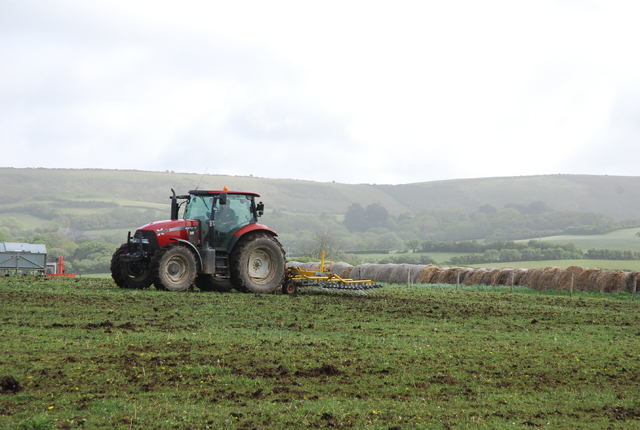
Buying the Farm
ROSS WILKEN, twenty-three, and his father, Harold Wilken, don’t look much like starry-eyed radicals as they inspect their fields of black beans just west of Danforth, Illinois. The hot, wet afternoon sun beats down on their greasy jeans and tired eyes like it does on any other farmer. But their twenty-three hundred acres of organic crops, surrounded by millions of acres of genetically modified corn and soybeans, are nothing short of an insurgency.
July 6, 2015 | Source: Orion Magazine | by Dean Kuipers
ROSS WILKEN, twenty-three, and his father, Harold Wilken, don’t look much like starry-eyed radicals as they inspect their fields of black beans just west of Danforth, Illinois. The hot, wet afternoon sun beats down on their greasy jeans and tired eyes like it does on any other farmer. But their twenty-three hundred acres of organic crops, surrounded by millions of acres of genetically modified corn and soybeans, are nothing short of an insurgency.
“These look really good,” says Ross, examining plants heavy with purplish pods. “I wish I had more acres in these.”
The black beans in this eighty-acre patch, just one of the Wilkens’ many nonadjacent fields scattered around the area, will fetch eighty cents per pound when sold in Munger, Michigan, and afterward might end up in your Chipotle burrito. That’s a tall premium compared to conventional beans, which fetch about fifty cents. The Wilkens get similarly good prices for their organic wheat, corn, pumpkins, soybeans, and alfalfa hay. So it’s no surprise this family enterprise is steadily expanding its operation in every way possible—building barns and grain bins, buying heavy equipment, experimenting with software, and taking in a son-in-law, a nephew, and a neighbor down the road as partners.
The challenge is finding the land. Like most farmers in Central Illinois, the Wilkens lease the majority of the land they farm. Now they need to buy or lease new fields to take through the three-year transition to organic. And they need to get there before Wall Street does.
New players with deep pockets have appeared in farm country—investors looking to buy up prime farmland and turn a profit on the steady upward trend of land prices and farm incomes. There have always been family offices and private investors who owned farms, but the scale has changed: in the last decade, huge pension funds, university endowments, banks, sovereign wealth funds, hedge funds, and new exchange-traded companies have sunk an estimated $25 billion into U.S. farmland.
That only represents about 1 percent of the $2.4 trillion in farmland in this country. But some activists already see a battle looming for the control of our nation’s food production, pitting multigenerational farmers with a long-term vision of sustainability against the short-term needs of large, conventional investment funds.
The stakes are very real. According to the Oakland Institute, a policy think tank specializing in social, economic, and environmental issues, the profits-first emphasis of these megascale investments can lead to the worst kind of absentee landlordism, resulting in badly managed farms, poor labor practices, disempowerment of farmers, and increased speculation in land prices. Investors could even choose to frack the land, or sell it to a golf course developer, if that’s more profitable than leasing to a local farmer.
This investment phenomenon shows no sign of slowing. Farmland has become a hot new asset class, and investment advisors say they’re getting loads of requests. Reports estimate there are investors with at least $10 billion looking for deals.
“These investors are looking for an asset class that gives them some real protection; in other words, a ‘real’ asset as opposed to a paper asset,” says Philippe de Lapérouse, managing director for agriculture consulting firm HighQuest Partners, which has helped drive this international phenomenon with its popular Global AgInvesting conference series. Farms are a tangible asset, but also produce dividends in the form of crops—like gold with yield.
And it’s an international phenomenon: a study by the International Land Coalition found that between 2000 and 2011, large investors bought or leased more than 500 million acres—an area eight times the size of Britain—in Africa, Asia, and South America. But de Lapérouse says there’s still plenty available, adding, “The investable universe for farmland for institutional investors is probably at about $1 trillion.” Which leads to serious questions about what investors intend to do with this land.
“As an organic farmer, we’re not interested in an investor who’s just in it for the dollar,” Harold Wilken says. “If they are, they’re not in it like us; we’re not in this for the dollar. So we don’t want to work with people who are only in it for that either.”
He’s not talking about profit; the Wilkens, father and son, are making money. He’s talking about time and the condition of the soil, environmental impacts, and the quality of the food he provides to human beings. Harold needs an investor that will put him on land he’ll never have to leave, and not force him to “mine” it—his term—for the sake of predictable profits.
When he first started to expand his organic operation about a decade ago, there was no source of money available with that kind of patience—so he had to help invent one. In 2007, he became the first farmer to team up with a new triple-bottom-line investment company called Iroquois Valley Farms.
